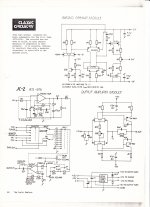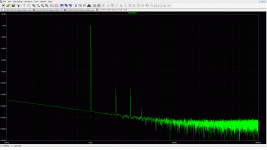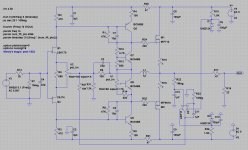What sounds good is purely subjective and varies with individuals.
Distortion in JFET input stage circuits
Patrick
Distortion in JFET input stage circuits
Patrick
What I find interesting is this: look at the attached schematic of the JC-2 John Curl published in the Audio Amateur in 1977, after some issues with Mark Levinson: the E5 is very similar to the phono amp, top, and the E4 looks a lot like the line amp, bottom, with an output stage added.
The E5 is based on a very common topology; the Marantz 15, from 1966, is a nice example, with BJT at the input. It's something that's (relatively) easy to get right, and suited for mass production, especially in the mid-fi area where it dominates.
The complementary differential JFet topology in the JC-2 line amp and the E4 is a totally different story: because of the fundamental difference between the N channel and the P channel, a perfect matching is impossible, as I've shown previously. And even a near matching, using Idss only, takes a lot of time and effort. Because of the difficulties, you only find them in the high end stuff.
So, I'm not surprised the E5, designed to be buildable/sellable, could sound better than the E4 under the same circonstances: it's easier to get right.
However, the E4 kit appeals to me because I think it has more potential for improvements, as shown in the link EUVL provided above. Consider it as a low cost starting point into the hi-end, hopefully, by playing with the operating conditions, the components, the supporting circuitries like the power supply and so forth. The only constrain I see is the layout of the PCB: it looks OK, but as of now, I don't know for sure if it's really up to my expectations.
Coming up next, I'll look into some details of the circuit.
The E5 is based on a very common topology; the Marantz 15, from 1966, is a nice example, with BJT at the input. It's something that's (relatively) easy to get right, and suited for mass production, especially in the mid-fi area where it dominates.
The complementary differential JFet topology in the JC-2 line amp and the E4 is a totally different story: because of the fundamental difference between the N channel and the P channel, a perfect matching is impossible, as I've shown previously. And even a near matching, using Idss only, takes a lot of time and effort. Because of the difficulties, you only find them in the high end stuff.
So, I'm not surprised the E5, designed to be buildable/sellable, could sound better than the E4 under the same circonstances: it's easier to get right.
However, the E4 kit appeals to me because I think it has more potential for improvements, as shown in the link EUVL provided above. Consider it as a low cost starting point into the hi-end, hopefully, by playing with the operating conditions, the components, the supporting circuitries like the power supply and so forth. The only constrain I see is the layout of the PCB: it looks OK, but as of now, I don't know for sure if it's really up to my expectations.
Coming up next, I'll look into some details of the circuit.
Attachments
Last edited:
It is interesting that you found the E5 to be better sounding than the E4. Does that mean that the Marantz HDAM input topology is better than the JC2 dual differential jFET? They have different driver stage too. Is it the driver stage that makes the major difference in sound?
I have a JC2 in a line preamp for awhile, it sounds very good to me. But I have never heard the E4. I expect the E4 to sound excellent too. My E19 headphone amp board is a practical copy of the E5.
I had high hopes for the E4, and while it’s not bad, it still doesn’t provide the same action as the E5, maybe a matched pair of k74 would help. Part of what I’ve appreciated the with the e5 could be the 4 Mundorf ag in it’s unregulated supply, but who knows. Could also be the electrolytic in the feedback loop on the e4 that’s pulling it down. A Nichicon Muse ES helped there, but the e5 has a nicer arrangement.
I may just break down and try an e19 since I can’t get ahold of an e5 anymore, and suffer through the changes required to make it work. Would be nice if Mr. Weiliang would make those again!
The E19 was gone for awhile. It just reappeared recently. Someone must heard your wish.
E19 Dual AC12V K2381 J407 Class A Headphone AMP Amplifier Finished Board YJ0050 | eBay
Phase, if anyone it will be you who can make it work.
E19 Dual AC12V K2381 J407 Class A Headphone AMP Amplifier Finished Board YJ0050 | eBay
Phase, if anyone it will be you who can make it work.
Copy of a copy; not from WeiLiang.
YJ0050-E19?????-???
The lastest Breeze E19 is a DAC portable headamp
??E19 ???? DAC ??? ES9028Q2M ?? TYPE-C?3.5??-???
Patrick
YJ0050-E19?????-???
The lastest Breeze E19 is a DAC portable headamp
??E19 ???? DAC ??? ES9028Q2M ?? TYPE-C?3.5??-???
Patrick
The E19 I have is from YuanJing, not Weilliang. But the circuit design is a copy of Weilliang's E5. My original E19 thread tried to clarified that. See quote below. The E5 board was out of production in 2016 already.Copy of a copy; not from WeiLiang.
YJ0050-E19?????-???
The lastest Breeze E19 is a DAC portable headamp
??E19 ???? DAC ??? ES9028Q2M ?? TYPE-C?3.5??-???
Patrick
The Breeze E19 ES9038Q2M DAC is a different animal with earphone out. Not a headphone amplifier.
I found the YuanJing assembled board at a very good price.
Yuan Jing Audio - E19 Class-A Headphone Amplifier - USD $30.00
I was attracted to its all descrete, MOSFET output section design. It has uPC1237 Speaker Protection Chip. The producer indicated high quality parts are used. But I cannot find any schematics or circuit information.
Edited September 15, 2016:
The E19 headphone amplifier board is NOT recommended for reasons that nattawa posted in #2. The hum problem is fixable, but you have a better, similarly priced, choice in Weiliang E5 board.
I wanted a front-end input using Marantz HDAM input structure,2SK170 matching of 1% for differential input, fully complementary MOSFET output, uPC1237 Protection Chip, and at least 500 mW into 50 ohms loads.
Last edited:
You can buy 2 set of matched quad 2sk170/2sj74 for $98 from punkydawgs. Is it good enough? And it is no longer low cost. It is cheaper to get a bunch of 2sk170 to test for 2 matched pair for the E5. It is much easier as you pointed out.The complementary differential JFet topology in the JC-2 line amp and the E4 is a totally different story: because of the fundamental difference between the N channel and the P channel, a perfect matching is impossible, as I've shown previously. And even a near matching, using Idss only, takes a lot of time and effort. Because of the difficulties, you only find them in the high end stuff.
So, I'm not surprised the E5, designed to be buildable/sellable, could sound better than the E4 under the same circonstances: it's easier to get right.
However, the E4 kit appeals to me because I think it has more potential for improvements, as shown in the link EUVL provided above. Consider it as a low cost starting point into the hi-end, hopefully, by playing with the operating conditions, the components, the supporting circuitries like the power supply and so forth. The only constrain I see is the layout of the PCB: it looks OK, but as of now, I don't know for sure if it's really up to my expectations.
Coming up next, I'll look into some details of the circuit.
Toshiba 2SJ74 + 2SK170 LAB MATCHED QUAD 0.03mA & 4mV (7-8ma "B" "BL" range) | eBay
Last edited:
No major change:
- Applied Mooly's Magic for a much cleaner FFT
- Cleaned up some components references
- Cleaned up some components values
Another settings on Transient Run.....
( Fundamental normalized )
Attachments
Last edited:
...
The lastest Breeze E19 is a DAC portable headamp
??E19 ???? DAC ??? ES9028Q2M ?? TYPE-C?3.5??-???
Patrick
Good guys: they're from the home town of Ip Man, Wong Fei Hung, and... me! 🙂
You can buy 2 set of matched quad 2sk170/2sj74 for $98 from punkydawgs. Is it good enough? And it is no longer low cost.
Good enough for sure. But if you want to go this way, you should consider using half of the input stage at half the cost.
Before I knew how well the Fets are matched from this seller, I had a plan B like this.
Attachments
Does complementary input sound better than differential input? You mentioned earlier that it is easier to match N vs. N-channel than N and P-channel.Good enough for sure. But if you want to go this way, you should consider using half of the input stage at half the cost.
Before I knew how well the Fets are matched from this seller, I had a plan B like this.
The maker/seller of the E19 headphone amp board claimed 1% matching of K170 pair for input.
The UTHAiM is a much better circuit for similar components.
Above all no global NFB.
Patrick
I fully agree. Your UTHAiM, and also the no FB complementary folded cascode are in the top tier in terms of topologies, as used, in one way or another, by CTC, Ayre, etc..., including yours truly as part of my thesis in 1975, but not in the complementary form.
But then it'd be difficult to achieve with a budget of $30. 🙁
Does complementary input sound better than differential input? You mentioned earlier that it is easier to match N vs. N-channel than N and P-channel...
See above.
If you have to go the differential route, it can be good, and even better with dual Fets. I once used the 2N5566 with satisfactory results.
Last edited:
The maker/seller of the E19 headphone amp board claimed 1% matching of K170 pair for input.
I couldn’t find that in any of the descriptions, is that something you’d learned after buying one?
Have one on the way, the adventure is beginning.
The E19 page at Yuan Jing Audio.I couldn’t find that in any of the descriptions, is that something you’d learned after buying one?
Have one on the way, the adventure is beginning.
Yuan Jing Audio - E19 Class-A Headphone Amplifier - USD $30.00
You made posts at the 2016 E19 thread that I started. natawa made very helpful mod suggestions. I hope to update the thread with my latest mod to the E19 in the next 2 weeks.
https://www.diyaudio.com/forums/headphone-systems/294456-e19-headphone-amplifier-board-k2381-j407-mosfet-yuanjing-audio.html#post4778402
Last edited:
> But then it'd be difficult to achieve with a budget of $30.
This you can truely DIY for §30, including etching your PCB.
the Headphone amplifier
Buying Ebay stuff is not DIY as far as I am concerned.
Cheers,
Patrick
This you can truely DIY for §30, including etching your PCB.
the Headphone amplifier
Buying Ebay stuff is not DIY as far as I am concerned.
Cheers,
Patrick
...
Buying Ebay stuff is not DIY as far as I am concerned.
...
Yes, but it's a cure to the worst curse for mankind: cutting and drilling. 🙂
I have built Dynaco kits, Heathkit, SWTPC kits since 50 years ago. Call it whatever you want. I also built audio gears from the pages of Popular Electronics, Audio Amateur and Wireless World. I found home built PCB quality to be inconsistent without dedicated equipment and had to find friends who had the proper equipment to do PCB for me. When DAC chip and other highly integrated IC become SMD only, home built PCB using kitchen sink etch box is no longer practical.> But then it'd be difficult to achieve with a budget of $30.
This you can truely DIY for §30, including etching your PCB.
the Headphone amplifier
Buying Ebay stuff is not DIY as far as I am concerned.
Cheers,
Patrick
I assemble my own PC computer too, using mostly Taiwanese ready made board level components and CPU/memory. Occasionally, I still do point to point wiring for simple component testing circuit.
Buying from e-bay may not qualify as DIY, but it is the only practical way to keep my hobby going. I am building a MC phono stage by Wayne Palmer, but it is an exception. I am also collecting parts to build power amp based on 4702 chip driver by jackinnj which will be another non-e-bay project. Wayne and Jack make their project possible for me by arranging their PCB source.
Last edited:
I have built Dynaco kits, Heathkit, SWTPC kits since 50 years ago...
If you built the Tigersaurus from Southwest Technical Products (SWTPC), maybe you know that Daniel Meyer, the designer, came up with the complementary differential topology at the same time as John Curl, but independently. A nice case of simultaneous invention.
In fact, I was familiar with Dan Meyer through the pages of Popular Electronics and discovered John Curl years later through Audio Amateur.If you built the Tigersaurus from Southwest Technical Products (SWTPC), maybe you know that Daniel Meyer, the designer, came up with the complementary differential topology at the same time as John Curl, but independently. A nice case of simultaneous invention.
I had the 60 watts original Tiger. SWTPC kit were not very robust and the sound was somewhat disappointing due to its output stage configuration. I soon built a mini version of James Bongiorno's Ampzilla. Mini because the supply voltage is 50 volts, not 75 and I made my own PCB. I still have the mini Ampzilla, but it is not working due to age. This was my first and best from scratch audio project.
- Home
- Amplifiers
- Headphone Systems
- The JC2-HPA Headphone Amplifier


